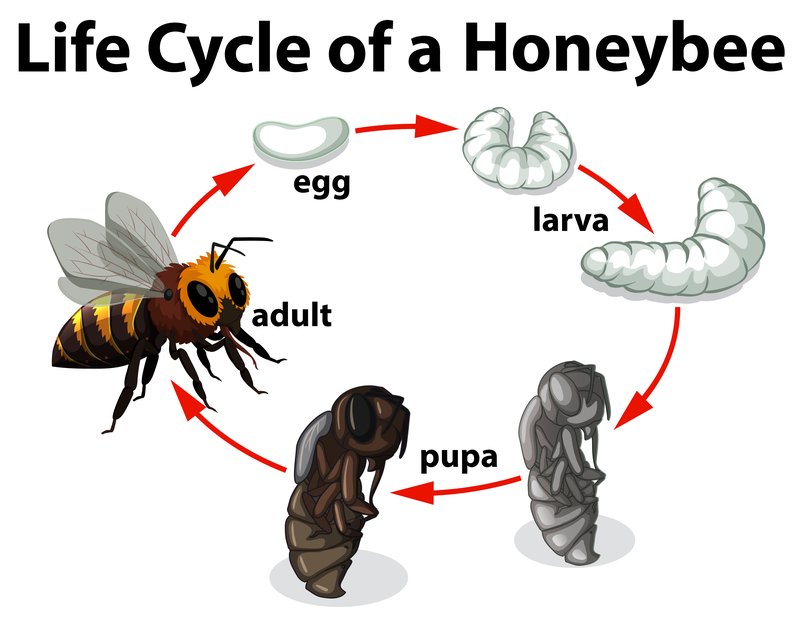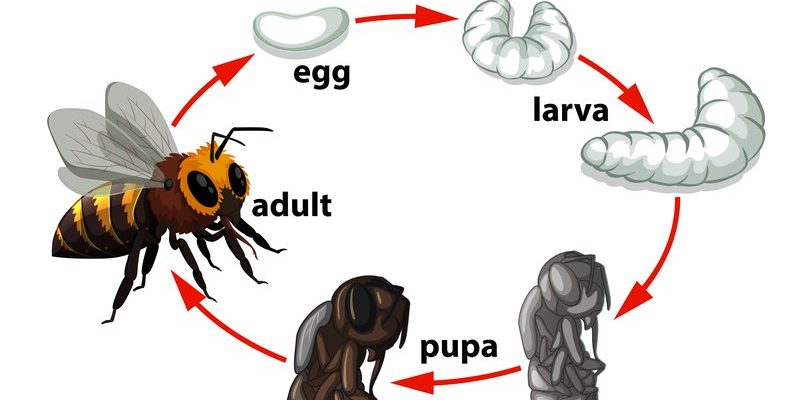
When you look at a honey bee, you might just see a little creature buzzing around flowers. But there’s so much more happening behind the scenes! The lifecycle of a honey bee is divided into several stages: egg, larva, pupa, and adult. Each stage has its own unique challenges and milestones. So, let’s break it down and explore this incredible lifecycle together.
The Egg Stage: The Beginning of Life
The journey of a honey bee starts with an egg, but it’s not just any egg. Honey bee eggs are laid by the queen bee in specially constructed hexagonal cells of beeswax. You might think of these cells as tiny cradles, perfectly designed for what’s to come. The queen lays her eggs in a controlled environment, ensuring they are safe and secure.
After about three days, the eggs hatch into larvae. This is a critical time because the larvae are incredibly vulnerable. They depend on the worker bees for everything—food, warmth, and protection. Honestly, it’s like being born into a family where everyone pitches in to help. The worker bees use honey and pollen to feed them, ensuring they get the nutrients needed to grow.
If you’re wondering how many eggs a queen can lay, here’s an interesting fact: she can lay up to 2,000 eggs per day during peak season! This remarkable capability keeps the hive thriving and is essential for maintaining the colony’s population.
The Larval Stage: Growing Up
Once the eggs hatch, the larvae enter an intense growth phase. Remember, they’re not just sitting around! They’re eating and growing rapidly for about five to seven days. During this time, they double in size and become quite voracious. It’s kind of like being a hungry teenager—always looking for snacks!
The worker bees continue to care for the larvae, feeding them a special substance called royal jelly. This isn’t just any food! Royal jelly is rich in proteins and nutrients, and it’s what differentiates the future queen bees from the worker bees. If a larva is fed just royal jelly, it will develop into a queen. If not, it stays a worker bee. Think of royal jelly as the golden ticket to becoming the leader of the hive.
Once they’re fully grown, the larvae spin a cocoon around themselves and enter the next stage of their development—the pupal stage.
The Pupal Stage: Transformation
Ah, the pupal stage! This is where the magic happens. After spinning their cocoons, the larvae undergo a transformation that’s almost like a superhero changing in a phone booth. Inside the cocoon, the larva starts to change into an adult bee. It’s a sort of metamorphosis, where all the body parts reorganize, and new structures are formed.
During this time, the bee doesn’t eat or move. It’s entirely dependent on the worker bees to keep the cocoon clean and safe. You might think of this as a really long nap, where all the hard work of growing has to happen behind closed doors.
This stage can last anywhere from 12 days for worker bees to about 16 days for queens. It’s crucial because, by the time they emerge, they are fully formed and ready to take on their roles in the hive.
Emergence: Breaking Free
After a few weeks of transformation, the moment arrives: the young honey bee is ready to emerge! This is a significant milestone. The new bee uses its mandibles to cut its way out of the cocoon. Imagine breaking out of a shell—you feel both excited and a bit unsure about the world outside.
Once it emerges, the young bee goes through a process called “tending.” This is where it cleans itself and gets familiar with its surroundings. The worker bees immediately recognize it as a new member of the hive and welcome it into the fold. It’s a warm, fuzzy moment—like a baby bird being hugged by its family!
Interestingly, new bees often stay inside the hive for a while before venturing out to forage. They first take on roles like cleaning cells or caring for younger larvae to gain experience.
The Adult Stage: Finding Your Role
Now that the honey bee is officially an adult, it’s time to find its place in the hive. Adult honey bees can take on various roles, including forager, nurse, guard, or even queen, depending on their age and the needs of the colony. Isn’t it cool to think they each have their own job?
Forager bees are the ones we often see buzzing around flowers, collecting nectar and pollen. They have specialized body structures that help them carry pollen back to the hive. If you observe closely, you’ll see them dancing their way back, communicating with other bees about where the best flowers are located. It’s like they’re sharing secret tips on where to find the best snacks!
On the other hand, younger bees may focus on tending to the queen and the brood. They help ensure that the hive runs smoothly. It’s a little like teamwork at a community center—everyone has a role to play to keep things organized and efficient.
The Importance of Honey Bees
You might wonder why all of this matters. Honey bees play a vital role in our ecosystem. They are essential pollinators, helping to fertilize plants so they can produce fruits and seeds. This process is crucial for our food supply. In fact, it’s estimated that honey bees are responsible for pollinating about one-third of the food we eat. Without them, our diets would look very different.
Beyond just our food, honey bees contribute to biodiversity. By pollinating various plants, they help maintain healthy ecosystems. Their presence supports wildlife and other insects, creating a balanced environment. Understanding their lifecycle helps us appreciate their role and take steps to protect them.
If you’ve ever considered beekeeping, knowing their lifecycle is key. It allows you to create the right conditions for the bees to thrive, ensuring they can fulfill their roles within the hive.
The lifecycle of a honey bee is nothing short of remarkable. From a tiny egg to a buzzing adult, each stage carries its weight in the grand scheme of nature. When you think about it, these little creatures are engineering marvels, contributing to our environment in ways we often overlook.
So next time you see a honey bee buzzing around, remember its incredible journey. Whether you’re enjoying a bite of fruit or marveling at a blooming flower, thank the honey bee for its hard work. Their lifecycle teaches us about growth, community, and the interconnectedness of all living things. It’s a beautiful reminder that even the tiniest creatures can have a big impact on our world.

